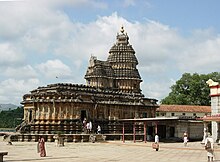Sringeri matha
| Acharya: Jagadguru Sri Bharati Tirtha Mahasannidhanam | |
|---|---|
 |
|
| Location | Shringeri |
| Founder | Adi Shankara |
| First Acharya | Maṇḍana Miśra (Sureshwaracharya) |
| Formation | 820 AD |
| Website | http://www.sringeri.net/ |
Sringeri Sharada Peetha is the southern Advaita Vedanta matha or monastery established by Adi Shankara in 8th century AD. The matha is on the banks of the Tunga River in Chikkamagalur district, Karnataka, India, 105 kilometers from Mangaluru and 303 kilometers from the state capital, Bengaluru.
Traditionally, Adi Shankara (8th century) is regarded as the greatest teacher and reformer of the Smartha. According to Alf Hiltebeitel, Shankara established the nondualist interpretation of the Upanishads as the touchstone of a revived smartha tradition. The Sringeri Sharada monastery founded by Shankara in Karnataka is still the centre of Smartha tradition .
Sankara is believed to have envisioned this place as the holy site where a snake unveiled his hood like a umbrella to protect a frog from the hot sun. According to tradition, it is one of four major temples established by Sankara.
As per Hindu legend, the place is associated with sage Rishyasringa, son of Vibhandankamuni. He did severe penance at this place, leading to the name Sringeri. The temple was renovated during the regime of Vijayanagara Empire during the 14-16th centuries and later during 1916.
Sureshwaracharya, who was Maṇḍana Miśra in his purvashrama, was installed as the successor of Shankaracharya before the latter resumed his tour to found his three pithas at Puri, Dwaraka and Badrinath.
During the Maratha–Mysore War in 1791, the Maratha Empire's army raided the temple and matha of Sringeri Shankaracharya, killing and wounding many people including Brahmins, plundering the monastery of all its valuable possessions, and desecrating the temple by displacing the image of goddess Sarada. The incumbent Shankaracharya petitioned Tipu Sultan for help. A bunch of about 30 letters written in Kannada, which were exchanged between Tipu Sultan's court and the Sringeri Shankaracharya were discovered in 1916 by the Director of Archaeology in Mysore. Tipu Sultan expressed his indignation and grief at the news of the raid:
...
Wikipedia
